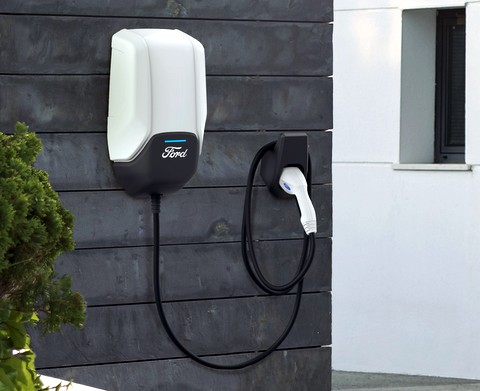Will Homes Soon Come with EV Charging Stations?
A Key Step To an Electric Future
Electric vehicles are taking the roads by storm, with a projected 26.4 million EVs in the United States by 2023. To support this shift into clean energy, charge ports are creeping up everywhere, even in thousands of new and renovated homes. What will the installation of EV stations look like and how soon will they be charging up in a home near you?
What Does an EV-Ready Home Look Like?

Most home outlets are already compatible with Level 1 charging. These homes would need a 240-volt upgraded with wiring and other electrical work to be compatible with faster Level 2 chargers. Luckily, many EV owners use this format as the charger usually comes with their car purchase. However, a more efficient and battery-saving Level 2 option needs a 50-amp circuit. The upgrade may require extra installation fees of up to $3,500.
These estimates are also based on single-family households with one electric vehicle in their garage. A multifamily home would need at least two charging spots and extra space for the wires and plugs.
Why Pursue Home Charging Stations?
Home charging stations for EVs promise a cleaner future. The transportation sector accounts for 30% of greenhouse emissions from the U.S., but electric vehicles emit zero tailpipe carbon emissions.
Pre-wired houses fit for EV stations will also save homeowners money in the long run. As EVs grow in popularity and more charging stations crop up, these homeowners are well-prepared for the greener and cleaner years to come.
Additionally, a charging station is great for resale value. When moving is the reality, a decent home value makes the process much more lucrative. During the selling process, an energy audit measures the efficiency of a home by looking at ductwork, windows and other amenities. An EV charging station represents a modern and innovative benefit for forward-thinking homebuyers and is sure to bring the resale value up a notch.
Home-based charging ports will also need to ramp up in more secluded areas as they may be far from common hubs and stations. A charging station readily available at home allows these drivers to go anywhere with a steady energy source at the end of the day.
Is Installation Already Happening?
Though it will not happen overnight, the mass installation and pre-wiring of new, single-family homes are well on their way. The International Code Council (ICC) recommends new homes be built with EV-ready codes to make these residential homes relevant for decades to come. The State of California passed a law recently that mandated that all new residential and some commercial buildings be “EV capable,” meaning the builder must provide electrical panel space, empty conduit and a termination box for a future 240-volt, 40-armp circuit.

Some construction companies are already taking up the torch and implementing 240-volt plugs and wiring in every new home. This is enough to power a single-family household car.
As the next generation of homebuyers rises, so does the demand for EV infrastructure. Millennials and Gen Z individuals place a high value on clean energy. The increased accessibility of EVs means they will look for homes that can charge their cars overnight.
The ICC found more than 9.6 million Americans will need proper plug-and-electric setups for their EVs by 2030. Clearly, the home is the best place for people to find reliable and affordable energy.
Greener Homes and Cleaner Roads
Green and electric energy is the future, and Americans are embracing it with pre-installation and wiring for EV stations. Future homebuyers can keep an eye out for these amenities in their next open house and take their sustainability to the next level.

The link in this statement:
“The International Code Council (ICC) recommends new homes be built with EV-ready codes to make these residential homes relevant for decades to come.”
Takes you to a proposal to revise the 2018 ICC. Did this happen? I don’t see those sections in the current 2021 code.
Excellent question, @Hank. We’ll dig a little deeper. I know DA adopted a similar regulation, but I’ve heard its enforcement is spotty. –ed.
@Hank,
Good question. We’ll check it out and let you know. We do know CA has a similar law on the books, but we hear the enforcenent is spotty. –ed.
I know Green is what everyone wants what about the flip side when the solar panels go bad, the batteries in these vehicles cannot be re-used, what is the plan for them when they are not in use anymore. We have gone from one hazard to another, is this really better? Its been said that both the batteries and the solar panels are Hazardous materials, what will be done in the disposal or should I say storage of these items?
@John Kepler,
All legimate concerns, and ones either that are being addressed or will be soon. I’m afraid “it’s been said” is not really a good argument. You’ve been driving around with toxic materials in your gaosline and diesel fuel for decades. I would argue the big batteries in modern EVs are less toxic pound-for-pound and more recyclable than the lead-acid that crank up your car every morning.
Yes, new stuff and change is challenging, but that’s the fun of it. Figure out how to make it work better. Cobalt mined by Congolese child labor a problem. Figure out how to make batteries without cobalt.
On a perosnal note. I don’t have any solar panels, but unlike me who lost power for three days in our recent storms here in Northern Caliofnria, my neighbors with solar panels and storage kept their lights on.
Plenty to talk about here (and ICE vehicles are disappearing anytime soon), and we encourage you to engage in serious dialogue about the unforeseen challenges we face. Let’s keep talking! –Ed.